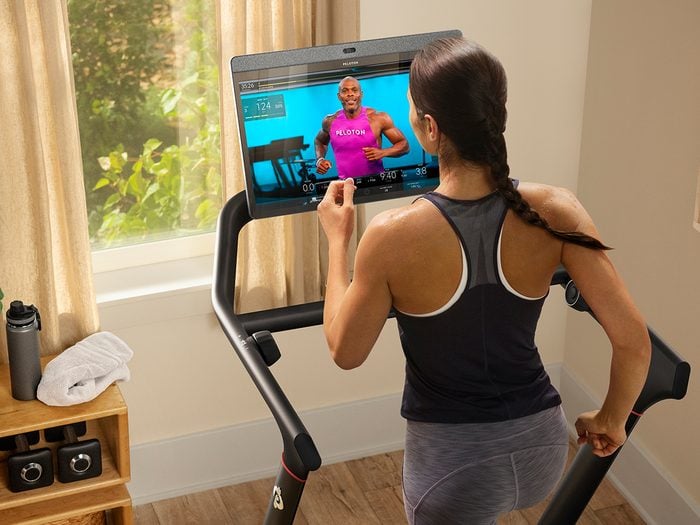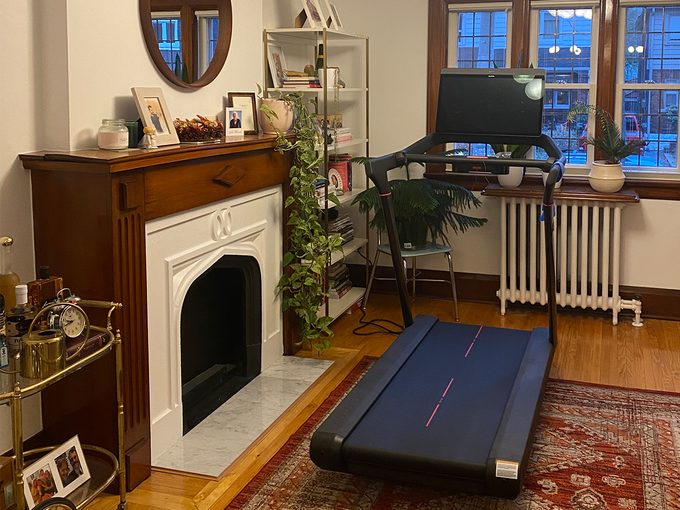Is the Peloton Tread Worth the Steep Price Tag? We Tried It

Peloton's treadmill is now available in Canada, and we put it to the test.
Like so many over the past 20 months, my home has become my gym. I was one of thousands of Canadians who invested in a Peloton spin bike during the pandemic and its daily classes immediately became part of my routine.
High-quality fitness equipment isn’t cheap (I know this first-hand after financing the bike). So, when the Peloton treadmill became available in Canada, I was curious to see if it was worth the hype—and the steep $3,295 price tag and additional $49 monthly subscription for Peloton’s classes, for those who don’t have the bike. Here’s what happened.
The logistics
The Peloton Tread is similar to the bike in how you use it: you can hop on the machine whenever you like and access a library of classes. It’s fitted with a nearly 24-inch touchscreen that tilts and easy-to-use knobs that control your speed and incline. The treadmill was released in Canada in early 2021, but recalled shortly after due to several reports of injuries from falling screens. The re-released Tread has addressed the screen issue and includes safety features like a required four-digit passcode to unlock the belt and a safety key that brings the treadmill to a quick stop.
While Peloton’s bike is ideal for small living spaces, the Tread needs room. First off, it weighs a lot—290 lbs—and is about 1.7 meters in length. While that is smaller than most couches, you also need at least two meters of clearance behind the Tread and just over half a meter of space on each side and in front of the machine for safety reasons. A similar amount of buffer space is needed above your head. In other words, you need to have a decent-sized home for this thing.
All the upstairs rooms in my old semi-detached home were too small to meet the space requirements and my basement’s ceilings were too low for the head clearance needs.
With all this in mind, the Peloton treadmill ended up in my living room.

Tips for getting started
The first time I got on the Tread, I was overwhelmed with all the class options: there are interval runs, recovery runs, HIIT runs, power walks and hikes all ranging from five minutes to an hour in length. You can join live scheduled classes or choose from on-demand ones. New classes are added daily. If I felt like doing my own thing, I could also use it as a normal treadmill or go on a scenic run in virtual locations like Iceland or Hawaii.
I’m a regular runner and I try to average five-kilometer runs when I’m outside, but I haven’t stepped on a treadmill since the pandemic began.
According to Peloton instructor Becs Gentry, a 20-minute class is the way to start. She recommends new members begin with a short music-themed ride where the classes are designed for all ability levels. “In fact, the main point of the run is to enjoy the music at whatever speed you fancy that day,” says Gentry.
I started with a 20-minute class with Peloton instructor Susie Chan. The class started with a warm-up, then progressed into a proper run which included some intervals and recovery time. Each time the instructor changes things up, a recommended speed and incline range appears on the screen. I was nervous at first to use the speed and incline knobs to change my speed as I was worried the belt would start flying under me. Thankfully, I had decent control and could slowly adjust my pace.
If you’re new to running, Jennifer Lau, a Toronto-based fitness coach at Fit Squad and a Nike Canada master trainer, says consistency in your training is key. “Building muscular and cardiovascular endurance is important,” Lau explains. “You can do that with frequency—maybe start [running] two to three times a week, and then as you build, you can build on the intensity and the length of your training on the treadmill.”
Lau also suggests new runners try interval training, which is where you use ratios for your workout and walk for two minutes, then jog for one minute, for example. “As you build your strength, you can start to play with those ratios so eventually you’re just walking for one minute and running for two minutes,” she says.
While running regularly throughout the week is great, it’s important to schedule time for the body to recover. Dr. Suzanne Steinbaum, a preventative cardiologist and member of Peloton’s Health and Wellness Advisory Council, emphasizes that runners should take at least one recovery day a week—but the harder you train the more of a break your body may need. If your body is sore, listen to it.
“Taking days off is not a ‘break;’ it is essential for recovery,” says Steinbaum. “On those off-days, do strength training, yoga or a stretching class. This active recovery from daily running will help improve your cardiovascular fitness and your ability to improve in your overall run on the Tread.”
Making running enjoyable
One thing I find challenging about running in general is that it can be boring—especially if you’re alone. The Peloton classes help solve for that. The instructors are often funny, play great music and make you feel like you’re running with a friend. As I got used to the Tread, I started to select runs based on the music, like 80s and 90s-themed classes. Just like the bike, each song brings a new running format: you might be doing interval sprints for one song, followed by a recovery jog the next, then an incline run to take you home. This format helps keep the workout interesting by mixing things up and pushes you to do your best for short bursts of time.
Peloton’s membership comes with a bunch of other classes like pilates, barre, bodyweight strength and stretching. The machine’s large screen makes it easy to follow a class on a mat next to the Tread. Because I still haven’t returned to an indoor gym, I really like that investing in a bike or treadmill actually gives you a bunch of exercise options.
The drawback
One thing I didn’t love about the Tread, however, was how loud the machine was when I was running. I understand all treadmills are relatively loud, especially when you’re sprinting on them, but for the price tag I was hoping the Peloton design would have been engineered to be quieter. I invited a friend over who grew up with the noise of her mom running on a treadmill in the basement—a sound she said vibrated through the entire house—to see if the amount of clamour was better or worse than her mom’s 20-year-old piece of machinery. She said that Peloton’s noise was comparable—even though I had my Tread on a rug to help absorb some vibrations. (When I was running, my partner could hear the thumps all throughout the house.) This noise makes me think the Tread is less than ideal for people living in apartments, condos or semi-detached homes. The bike, on the other hand, is nearly silent.
Noise complaints aside, I really liked the treadmill and if I had a larger home with more space I would consider investing in the equipment—especially since new classes are always being added and I don’t love running in the cold. But with the hefty price tag, size and noise, I’ll stick to outdoor running for now.




